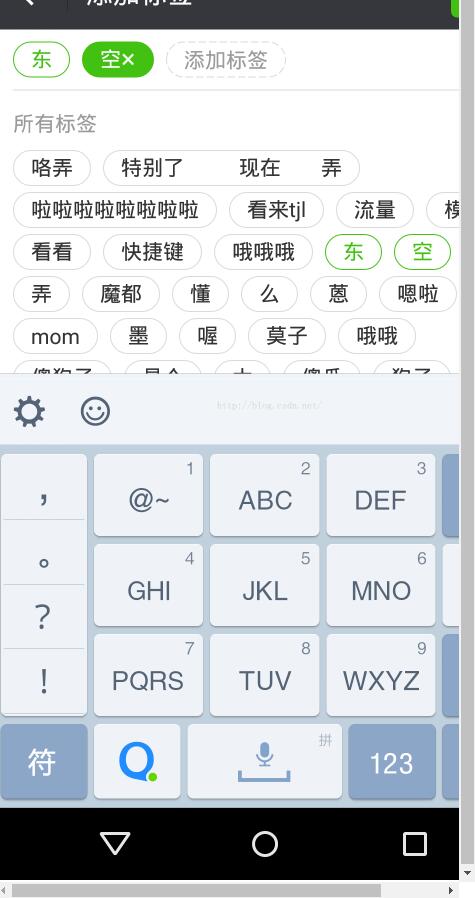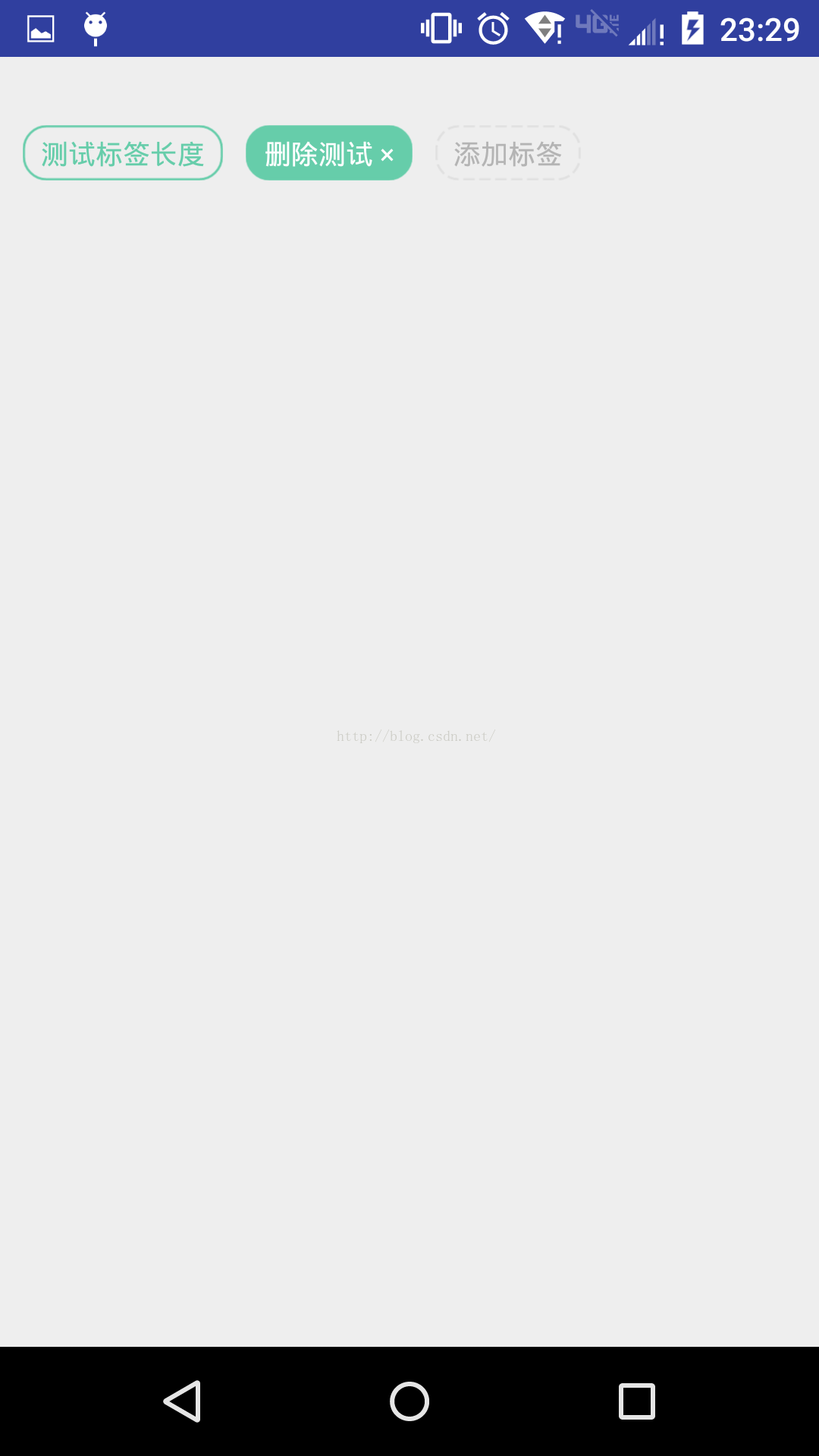微信中有对联系人添加标签的功能,如下图所示。

这里有三种状态的标签,分别的未选择,选中,编辑中,由于前两种标签不需要提供输入,所以用TextView实现即可,编辑中的标签用EditText来实现。而标签的形状就用Shape来实现。
在drawable下新建xml文件,这里先上Shape的xml文件。
tag_normal.xml
<?xml version="1.0" encoding="utf-8"?><shape xmlns:android="http://schemas.android.com/apk/res/android" android:shape="rectangle" > <corners android:bottomLeftRadius="10dp" android:bottomRightRadius="10dp" android:topLeftRadius="10dp" android:topRightRadius="10dp" /> <stroke android:width="1dp" android:color="#66CDAA" /> <padding android:bottom="4dp" android:left="8dp" android:right="8dp" android:top="4dp" /> </shape>
tag_selected.xml
<?xml version="1.0" encoding="utf-8"?><shape xmlns:android="http://schemas.android.com/apk/res/android" android:shape="rectangle" > <corners android:bottomLeftRadius="10dp" android:bottomRightRadius="10dp" android:topLeftRadius="10dp" android:topRightRadius="10dp" /> <stroke android:width="1dp" android:color="#66CDAA" /> <padding android:bottom="4dp" android:left="8dp" android:right="8dp" android:top="4dp" /> </shape>
tag_edit.xml
<?xml version="1.0" encoding="utf-8"?><shape xmlns:android="http://schemas.android.com/apk/res/android" android:shape="rectangle" > <corners android:bottomLeftRadius="10dp" android:bottomRightRadius="10dp" android:topLeftRadius="10dp" android:topRightRadius="10dp" /> <!-- 这里实现虚线边框--> <stroke android:dashWidth="5dp" android:dashGap="2dp" android:width="1dp" android:color="#e0e0e0" /> <padding android:bottom="4dp" android:left="8dp" android:right="8dp" android:top="4dp" /></shape>
接着在在布局文件中新建一个LinearLayout用以存放标签(如果要实现多行标签自适应添加,用自定义的FlowLayout,代码网上很多。)
activity_main.xml
<?xml version="1.0" encoding="utf-8"?><LinearLayout xmlns:android="http://schemas.android.com/apk/res/android" xmlns:tools="http://schemas.android.com/tools" android:id="@+id/tag_container" android:layout_width="match_parent" android:layout_height="match_parent" android:orientation="horizontal" tools:context="com.qtree.tagdemo.MainActivity"> </LinearLayout>
根据对微信标签的分析,这里可以这样实现,创建一个EditText,对其软键盘的Enter和Delete按键进行监听,当输入完成后按下Enter则生成一个标签,添加到LinearLayout中。然后如果当标签内文字为空时,按下删除键,就将它前一个标签的状态修改为选中状态。同样地,当点击未选择的标签也可以选中该标签进行删除。
详细实现如下
package com.qtree.tagdemo; import android.graphics.Color;import android.support.v7.app.AppCompatActivity;import android.os.Bundle;import android.text.Editable;import android.text.TextWatcher;import android.util.Log;import android.view.KeyEvent;import android.view.View;import android.view.ViewGroup;import android.widget.EditText;import android.widget.LinearLayout;import android.widget.TextView;import java.util.ArrayList;import java.util.List; public class MainActivity extends AppCompatActivity { private LinearLayout layout; private LinearLayout.LayoutParams params; @Override protected void onCreate(Bundle savedInstanceState) { super.onCreate(savedInstanceState); setContentView(R.layout.activity_main); layout=(LinearLayout)findViewById(R.id.tag_container); params=new LinearLayout.LayoutParams(ViewGroup.LayoutParams.WRAP_CONTENT, ViewGroup.LayoutParams.WRAP_CONTENT); params.setMargins(30,30,0,0); //存放标签和标签选择状态 final List<TextView> tagView=new ArrayList<>(); final List<Boolean> tagViewState=new ArrayList<>(); //创建编辑中的标签 final EditText editText=new EditText(getApplicationContext()); editText.setHint("添加标签"); //设置固定宽度 editText.setMinEms(4); editText.setTextSize(12); //设置shape editText.setBackgroundResource(R.drawable.tag_edit); editText.setHintTextColor(Color.parseColor("#b4b4b4")); editText.setTextColor(Color.parseColor("#000000")); editText.setLayoutParams(params); //添加到layout中 layout.addView(editText); //对软键盘的Enter和Del键监听 editText.setOnKeyListener(new View.OnKeyListener() { @Override public boolean onKey(View v, int keyCode, KeyEvent event) { if (KeyEvent.ACTION_DOWN == event.getAction()) { switch (keyCode) { case KeyEvent.KEYCODE_ENTER: String editTextContent = editText.getText().toString(); //判断输入是否为空 if (editTextContent.equals("")) return true; //判断标签是否重复添加 for(TextView tag:tagView){ String tempStr=tag.getText().toString(); if(tempStr.equals(editTextContent)) { Log.e("tag","重复添加"); editText.setText(""); editText.requestFocus(); return true; } } //添加标签 final TextView temp = getTag(editText.getText().toString()); tagView.add(temp); tagViewState.add(false); //添加点击事件,点击变成选中状态,选中状态下被点击则删除 temp.setOnClickListener(new View.OnClickListener() { @Override public void onClick(View v) { int curIndex = tagView.indexOf(temp); if (!tagViewState.get(curIndex)) { //显示 ×号删除 temp.setText(temp.getText() + " ×"); temp.setBackgroundResource(R.drawable.tag_selected); temp.setTextColor(Color.parseColor("#ffffff")); //修改选中状态 tagViewState.set(curIndex, true); } else { layout.removeView(temp); tagView.remove(curIndex); tagViewState.remove(curIndex); } } }); layout.addView(temp); //让编辑框在最后一个位置上 editText.bringToFront(); //清空编辑框 editText.setText(""); editText.requestFocus(); return true; case KeyEvent.KEYCODE_DEL: int lastIndex = tagView.size() - 1; //没有添加标签则不继续执行 if (lastIndex < 0) return false; //获取前一个标签 TextView prevTag = tagView.get(lastIndex); //第一次按下Del键则变成选中状态,选中状态下按Del键则删除 if (tagViewState.get(lastIndex)) { tagView.remove(prevTag); tagViewState.remove(lastIndex); layout.removeView(prevTag); } else { String te = editText.getText().toString(); if (te.equals("")) { prevTag.setText(prevTag.getText() + " ×"); prevTag.setBackgroundResource(R.drawable.tag_selected); prevTag.setTextColor(Color.parseColor("#ffffff")); tagViewState.set(lastIndex, true); } } break; } } return false; } }); //监听编辑标签的输入事件 editText.addTextChangedListener(new TextWatcher() { @Override public void beforeTextChanged(CharSequence s, int start, int count, int after) { } @Override public void onTextChanged(CharSequence s, int start, int before, int count) { //输入文字时取消已经选中的标签 for (int i = 0; i < tagViewState.size(); i++) { if (tagViewState.get(i)) { TextView tmp = tagView.get(i); tmp.setText(tmp.getText().toString().replace(" ×", "")); tagViewState.set(i, false); tmp.setBackgroundResource(R.drawable.tag_normal); tmp.setTextColor(Color.parseColor("#66CDAA")); } } } @Override public void afterTextChanged(Editable s) { } }); } /** * 创建一个正常状态的标签 * @param tag * @return */ private TextView getTag(String tag){ TextView textView=new TextView(getApplicationContext()); textView.setTextSize(12); textView.setBackgroundResource(R.drawable.tag_normal); textView.setTextColor(Color.parseColor("#66CDAA")); textView.setText(tag); textView.setLayoutParams(params); return textView; } } 
效果挺好。
以上就是本文的全部内容,希望对大家的学习有所帮助,也希望大家多多支持VEVB武林网。
注:相关教程知识阅读请移步到Android开发频道。
